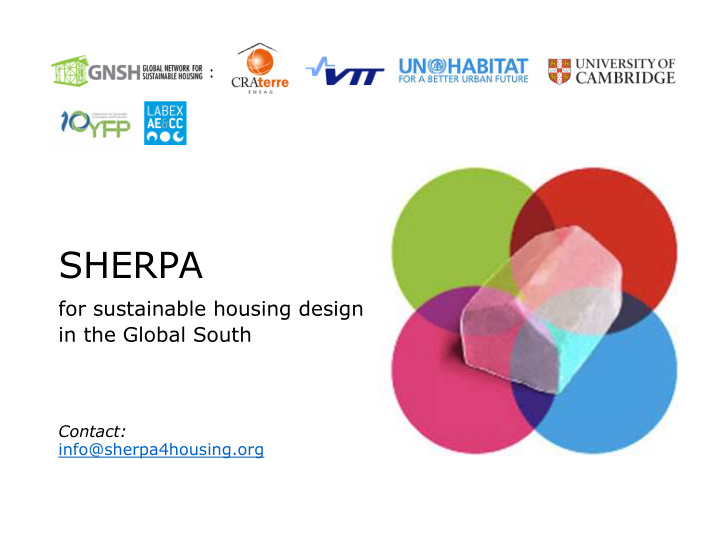



: SHERPA for sustainable housing design in the Global South Contact: info@sherpa4housing.org
Context of New Urban Agenda 2. By 2050 the world urban population is expected to nearly double, […] this poses massive sustainability challenges in terms of housing, infrastructure, basic services, food security, health, education, decent jobs, safety, and natural resources , among others. 9. This New Urban Agenda reaffirms our global commitment to sustainable urban development […] www.sherpa4housing.org Source: New Urban Agenda (Quito, 2016)
Need for New Guideline Tool “Africa will have the largest growth of population in cities the coming decades and they are asking openly not being imposed external rating tools as guidelines for their development.” “They have a need of reinforcing their own models focusing on culture as a design value and community management as the fundamental base for sustainable development .” www.sherpa4housing.org Source: World Sustainable Building Conference, Barcelona, 2014
Vision behind SHERPA “Housing as a lever for sustainable development” - Philippe Garnier, CRAterre Maximise sustainability through: • holistic view on housing impact • local capacity building • process-driven focus • ability to self-evaluate • free and open-source development www.sherpa4housing.org
Sustainability Criteria www.sherpa4housing.org
Four Housing Project Scales Project processes 1. Context analysis 2. Project governance and management Neighbourhood 3. Participation and capacity building 1. Planning and cultural suitability 2. Urban design for cultural identity and social cohesion Territory 3. Urban rural interface 4. Land tenure 1. Water and sanitation 2. Solid waste 3. Mobility and networks Household 4. Energy 5. Food security and livelihoods 1. Building design 6. Social and community cohesion 2. Architectural and building techniques 3. Building elements 4. Appliance and equipment www.sherpa4housing.org
Self-Evaluation Questionnaire PROCESSES Section 3) PARTICIPATION AND CAPACITY BUILDING 3.1 To what degree were stakeholders involved in the architectural design process? There are several levels of participation ranging from 'no participation' to 'decision'. Are the existing techniques of participative design applied? Are different options proposed and understood by all the participants? Not at all Informed Consulted Active Stakeholders were Stakeholders were Stakeholders were Stakeholders had not informed during informed during the consulted during an active role in the the architectural architectural design the architectural architectural design design process. process. design process. process. www.sherpa4housing.org
Access to SHERPA as Mobile App www.sherpa4housing.org
Pilot Projects in Global South Nepal Algeria Egypt India Mali Haiti Senegal Burkina Faso Nicaragua Venezuela Guinea Benin Colombia Kenya DRC KENSUP www.sherpa4housing.org + projects 4 12
Application for SHERPA Programme-level: • Monitoring and implementation tool for New Urban Agenda • Guide priorities and assessment criteria for new programmes Project-level: • Guide brief, scope, and targets • Methodology for capacity building • Monitor performance of ready funded projects • Post-evaluation to feed into future projects www.sherpa4housing.org
: www.sherpa4housing.org KENSUP
Recommend
More recommend